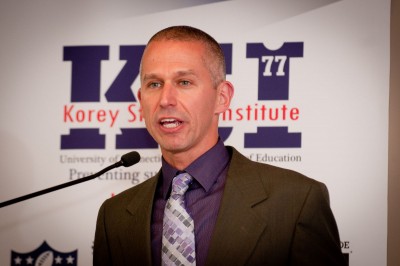By: Douglas Casa, PhD, ATC, FACSM, FNATA, Chief Executive Officer, Korey Stringer Institute, Department of Kinesiology, University of Connecticut
 The story that Kent recounts was the seminal moment of my life. I have nearly no memory of approximately 6 hours of my life, while I was in a coma due to severe exertional heat stroke. A few lingering snapshots from those 6 hours dangle inside my mind, which I occasionally see at the oddest of moments. For instance, I remember saying my dad’s work phone number, the only comprehensible item to leave my mouth in the 6-hour span. Why I could recite that number over my home number is still a mystery to me. I still wonder if a call to my dad about my demise would have been better than the news being delivered to my mother. It’s amazing how the mind functions at such stressful times. I also remember\ chaos and worry and desperation surrounding me at one point in the emergency room and the calming sound of a person in charge (who I came to realize later during my hospital stay was the physician in charge of my care). I also oddly remember ice-water towels on me during the ambulance ride and a peculiar combination of oppressive, crushing heat and wonderfully cold water dripping on my chest.
The story that Kent recounts was the seminal moment of my life. I have nearly no memory of approximately 6 hours of my life, while I was in a coma due to severe exertional heat stroke. A few lingering snapshots from those 6 hours dangle inside my mind, which I occasionally see at the oddest of moments. For instance, I remember saying my dad’s work phone number, the only comprehensible item to leave my mouth in the 6-hour span. Why I could recite that number over my home number is still a mystery to me. I still wonder if a call to my dad about my demise would have been better than the news being delivered to my mother. It’s amazing how the mind functions at such stressful times. I also remember\ chaos and worry and desperation surrounding me at one point in the emergency room and the calming sound of a person in charge (who I came to realize later during my hospital stay was the physician in charge of my care). I also oddly remember ice-water towels on me during the ambulance ride and a peculiar combination of oppressive, crushing heat and wonderfully cold water dripping on my chest.
The most important part of my story stems from the night of my collapse. After being released from intensive care to a regular hospital room, I watched the local late-night news at 11:00 P.M. and watched them tell the story of my exertional heat stroke. It was powerful to lay alone (Buffalo was 10 hours from my house on Long Island) in a hospital room -utterly exhausted yet peacefully thankful -and watch a news account about myself. On August 8, 1985, somewhere between 11:00 and 11:10 P.M. EST, the path of my life unfurled in front of me. For all the years since then, I have been on a quest to try to prevent and treat exertional heat stroke. My story is not overly complicated. My survival penance has been to save as many lives as posssible from heat stroke and to prepare others who can do the same. The following story from Benjamin Arthur is one such example of the lives I have been able to touch.
While exertional heat stroke is one of the most common fatalities related to sports, it certainly is not the only one. This book is the culmination of the efforts of more than 30 of the most respected sports medicine professionals and scientists in the world related to preventing sudden death in sports. It is another chance for me to recognize my gift of survival and pay it forward with information about the top 10 causes of death in sport that can assist in creating more survival stories. I have experienced a wide array of emotions in my life, but no feeling is greater than playing a role in saving a life. When you see a person like Ben, whom you helped save, it stops you in your tracks and you realize your life has purpose.
Excerpt from Preventing Sudden Death in Sport and Physical Activity, Edited by: Douglas J. Casa, PhD, ATC, FACSM, FNATA, Publisher: Jones&Bartlett
Kent Scriber’s Story – August 8, 1985
By Kent Scriber, EdD, ATC, PT, Professor, Department of Exercise and Sport Sciences, Ithaca College
 Almost every year since the early 1980’s, I have served as a volunteer athletic trainer for the New York State Empire State Games (ESG). These annual games, generally held in late July, serve as a statewide Olympic-type event for several thousand amateur athletes. I was assigned as the head athletic trainer for Athletics (track and field) during the 1985 Empire State Games that were held in Buffalo, New York. Although this was quite some time ago, I vividly recall a frightening life-threatening scenario that has had a tremendous impact on me in many ways.
Almost every year since the early 1980’s, I have served as a volunteer athletic trainer for the New York State Empire State Games (ESG). These annual games, generally held in late July, serve as a statewide Olympic-type event for several thousand amateur athletes. I was assigned as the head athletic trainer for Athletics (track and field) during the 1985 Empire State Games that were held in Buffalo, New York. Although this was quite some time ago, I vividly recall a frightening life-threatening scenario that has had a tremendous impact on me in many ways.
The scholastic boys’ 10,000-meter run started in the late morning. Although I’m not certain of the exact temperature and humidity readings, it was definitely a hot and humid morning. I was positioned with a physician outside the track around the 250-meter mark, or somewhere between the third and fourth turns. On the final lap, we noticed the third-place runner staggering. He collapsed just as he was coming into the turn. He stood up, took a few more strides, and then collapsed again. He was lying unconscious not more than a hundred meters from the finish line. His coaches quickly warned the physician and me not to touch this young athlete because he would be disqualified and lose his chance at a medal.
Ignoring the coaches’ request, we were quickly able to get the athlete to the ambulance area, which was stationed very near where he happened to collapse. He was initially placed in the shade of the ambulance, and ice bags and wet towels were placed on his neck, forehead, axilla, and groin areas while the emergency medical technicians (EMTs) called the emergency room (ER) where he was to be transported. Initially, the Empire State Games physician at the site ordered the administration of IV fluids. However, the EMTs would not administer it without approval from the ER physicians. Instead, the athlete was placed in the back of the ambulance, which also was warm since it had been sitting in direct sunlight.
Precious minutes passed before the ambulance left the venue. Although I do not recall the patient’s core temperature at the time, I later heard it was above 106°F (rectal) when he arrived at the ER.
After several hours of concern about this young man’s health status, I was greatly relieved to learn later that afternoon that our young runner’s core temperature had quickly returned to normal and that he was conscious and alert. If memory serves me correctly, he returned to the track in two days to cheer on his teammates.
The Empire State Games sports medicine staff wanted to ensure that this type of heat-related episode would never again occur (a road cyclist also had a serious heat illness on the same day). The night of the emergency, the staff met to determine what precautionary measures could be implemented. They determined that athletes could have water during their races, longer endurance events would take place in the earlier part of the day, and several events would take mandatory breaks during their competitions (e.g., soccer played periods instead of halves and took rest and hydration breaks between each). Later, certain policies and procedures for the care of athletes were also changed to better care for future emergency situations. In particular, a clearer chain of command was established to avoid confusion and discussions relating to who was responsible for whom at the time of an emergency. The 1985 Empire State Games ended with no further serious heat-related incidents.
In the years since this near-catastrophic event, I have discussed this scenario with my athletic training students for a number of reasons. Obviously, a major teaching point is the need to be knowledgeable and prepared ahead of time for heat-related problems and other emergencies. In addition to the xvi FOREWORD administration of the most appropriate treatment plan, of great importance is the establishment of a clearly communicated emergency action plan that can facilitate emergency care quickly when there is a potentially life-threatening situation.
For many years I was somewhat curious about the young man from Long Island who had collapsed on that fateful day and wondered what had happened to him. Through an interesting set of circumstances at the 2001 NATA Clinical Meeting and Symposium in Los Angeles, I found out that the young man who had collapsed from exertional heat stroke that day was Douglas Casa. We have since spent time together as professional colleagues. We have been able to visit each other’s campuses, speak to each other’s students and faculty members, serve on national committees together, and collaborate on a publication. Most important, we have developed a wonderful friendship. I was impressed with Dr. Casa’s research long before I realized our paths had crossed years earlier. I still remain in awe of Dr. Casa’s passion for the work he does, and I am proud to know that my actions many years ago have been a catalyst for the work that he has done since then.
Excerpt from Preventing Sudden Death in Sport and Physical Activity, Edited by: Douglas J. Casa, PhD, ATC, FACSM, FNATA, Publisher: Jones&Bartlett